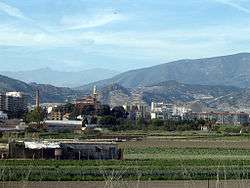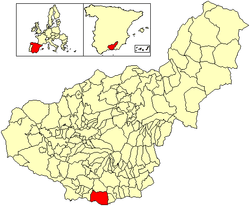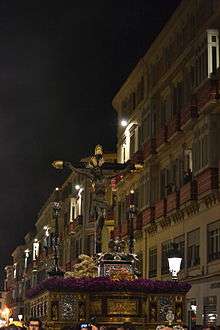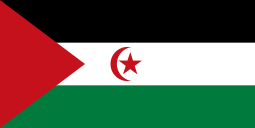Motril
| Motril | |||
|---|---|---|---|
| Municipality | |||
 | |||
| |||
 Location of Motril | |||
 Motril Location in Spain | |||
| Coordinates: 36°45′N 3°31′W / 36.750°N 3.517°WCoordinates: 36°45′N 3°31′W / 36.750°N 3.517°W | |||
| Country |
| ||
| Autonomous community |
| ||
| Province | Granada | ||
| Comarca | Costa Tropical | ||
| Judicial district | Motril | ||
| Commonwealth | Costa Tropical de Granada | ||
| Government | |||
| • Alcaldesa | Luisa García Chamorro (2012) (PP) | ||
| Area | |||
| • Total | 109.77 km2 (42.38 sq mi) | ||
| Elevation | 45 m (148 ft) | ||
| Population (2012) | |||
| • Total | 61,171 | ||
| • Density | 560/km2 (1,400/sq mi) | ||
| Demonym(s) | Motrileño, -ña | ||
| Time zone | CET (UTC+1) | ||
| • Summer (DST) | CEST (UTC+2) | ||
| Postal code | 18600 - 18613 | ||
| Website | Official website | ||
Motril is a town and municipality on the Mediterranean coast in the province of Granada, Spain. It is the second largest town in the province, with a population of 61,171 as of 2012.[1] The town is located near the Guadalfeo River and 69 km (43 mi) from Granada. The council of Motril includes the city of Motril and the neighbourhoods of El Varadero, Torrenueva, Carchuna, Calahonda, Puntalón, Playa Granada, Las Ventillas, La Perla, La Garnatilla and La Chucha. The town is the capital of the region of the Coast of Granada.
King Baudouin of the Belgians died in Motril of heart failure during a visit to their summer residence, "Villa Astrida" in 1993.
History
Although its origin still remains hidden, it was a Phoenician enclave. It already existed in Roman times, although we cannot say it was one of cities named Murgis, mentioned in Baetica by Pliny the Elder and Ptolemy.

When the Christians conquered Motril, there were 2000 inhabitants for agriculture, fishing and the production of silk and sugar. The villa occupied 3.5 km (2.2 mi). Outside the city there are two suburb: Al-Majon suburb and al-Couruch suburb and a neighborhood called Jandara.
In Motril’s history, there was a Moorish uprising in 1596 that finished in 1570 with the Christians’ victory. This made a recession of sugar production but this finished 5 years later with the repopulation of old Christians.
By the end of XVI,”Nuestra Señora de la Cabeza’s” church was built.
Sugar cane was the most important crop, which was later processed in the sugar refineries. The most important was "La Casa de la Palma". Now it’s the place where the “Museo Preindustrial de la Caña de Azúcar” is found.
In 1657, Philip IV granted Motril the title of city, separating its jurisdiction from Granada.
At the beginning of the next century, Philip V distinguished Motril as “Muy Noble y Leal”, which is now found on Motril’s shield.
After the War of Independence, in which Motril was occupied by French troops, the city started a new expansion of sugarcane and the sugar industry.
In the 19th century Motril participated in a singular event, it was proclaimed Independent Canton from July 22 to 25 of 1873. In a few years, due to the increase in the number of sugar refineries, it went to the first position in the Granada industrial ranking. It opened to the public on most traditional ride in the city, “Las Explanadas”, in the mid-19th century.
In 2011, the PP with Carlos Rojas got the mayoral service for a third time, with absolute majority. In 2012 he left his charge of mayor to be a spokesman of the “Partido Popular Andaluz”, leaving the mayoral service to Luisa Garcia Chamorro.
Monuments
Sugar Cane Refineries
Motril is synonymous with sugar, sugar cane. The process from sugar cane transformation into various types of sugar, even liquors like the cherished rum of Motril, has always been the basis of our economy. Sugar refineries were for many years the "future" of the city. Now they are one of Motril's legacies. The sugar cane in Motril has always been, and should keep being a source of richness.
Sugar cane refineries in Motril are
- Nuestra Señora del Pilar.
- Nuestra Señora de la Almudena.
- Azucarera de San Luis.
- Nuestra señora de Lourdes.
- Nuestra Señora de la Cabeza (Alcoholera).
- Nuestra Señora de las Angustias (Fabriquilla).
- Azucarera de San Fernando (sólo queda la chimenea).
- Ingenio de San José, El Varadero (sólo queda una nave).
Nuestra Señora de la Cabeza (Alcoholera)
This refinery is located next to the public swimming pool and the Parque de las Américas. It was founded by the Larios family in 1885, a family which founded a company based on the production of sugar and alcohol. At present, the company makes gin.
History
In the past, many people lived thanks to the work of the refineries due to the sugar cane. Due to the low salaries, later, the workers burned the refinery. The sugar refinery won't be destroyed, as the Town Hall wanted, because it has been declared of historic heritage by the Andalusian Government. Also the chimney, store, distillery and the terrain are protected.
Nuestra Señora de las Angustias (La Fabriquilla)
Leaving Motril, towards Puntalón and La Garnatilla we find the sugar refinery of Nuestra Señora de las Angustias, dated 1868 and from which are restored some premises now intended for municipal usage, highlighting the magnificent "Nave de los Arcos". Juan Ramón La Chica owned two refineries called "Nuestra Señora de las Angustias", but one of them was in Granada and the other one in Motril. He gained full ownership over this last one in 1874. He also owned another sugar cane refinery called "Nuestra Señora del Carmen" in Pinos Puente (Granada).
Religious Buildings
- Iglesia Mayor de la Encarnación.
- Santuario de Nuestra Señora de la Cabeza (conocido como "El Cerro de la Virgen")
- Iglesia de la Divina Pastora (Capuchinos).
- Santuario de Nuestra Señora de la Victoria.
- Ermita de la Virgen del Carmen.
- Iglesia del Convento de las Nazarenas.
- Ermita de Nuestra Señora de las Angustias.
- Ermita de San Antonio de Padua.
- Ermita de San Nicolás.
- Ermita del Señor de Junes.
- Capilla del Santo Rosario
Santuario de Nuestra Señora de la Cabeza
This church is one of the most important and emblematic monuments in Motril. It is on a hill called Virgin’s Hill. The church was built on the ruins of a nazari fortress in the 17th century by the architect Isidro de la Chica. The building was damaged during the Civil War in the 20th century and it was restored by the sculptor Manuel Gonzales, a sculptor from Motril, in the 1960s. Inside the church is the patron saint of Motril, the Virgen de la Cabeza. Nowadays, the church is next to the Parque de los Pueblos de América and the first fountain built in Motril where there is a big Spanish flag.
Population
Motril has 61,171 inhabitants spread out over 557.27/km2 (1,443.3/sq mi) as of 2012. There had been increasing of population, the emigration was the first cause. Until 1610 that they were 4,300 inhabitants, from now on (2012) 61,171 inhabitants, the population kept growing the last centuries.
Agriculture
Situated in the south coast of Andalusia, Motril has main crops like avocado, custard apple, guava, mango and banana; as well as greenhouse cultivation and sugarcane (but 2006 was the last year in which sugarcane was cultivated).
In the ancient countryside of Motril was very important the sugarcane to the production of sugar, for that Motril have several sugar refineries such as:
- “Nuestra Señora del Pilar”
- “Nuestra Señora de la Almudena”
- “Azucarera de San Luis”
- “Nuestra señora de Lourdes”
- “Nuestra Señora de la Cabeza”
- “Nuestra Señora de las Angustias”
- “Azucarera de San Fernando”
- “Ingenio de San José, El Varadero”
These refineries are now abandoned. The potato was also very important.
Motril and the villages belonging to the municipality: Torrenueva, Carchuna, Calahonda, Castel de Ferro... live of the crops in greenhouse. On one hand we have crops in greenhouse, the more importants are the tomatoes and the cucumbers. And on the other hand in a more reduced proportion crops outside such as custard apple, beans, peas...
Industry
Its geographical position makes it a commercial and industrial centre, the most important industry in Motril is the paper mill that gives 400 jobs and produce around 250 tons of paper per year. “The Port of Motril” is a commercial and fishing [port], this is the second most important industry in Motril after [paper industry]. There is a famous museum in Motril, "The Sugarcane Museum" because, some years ago, there was a [sugarcane] refinery, where they extracted the sugar to sell it.
Climate
Motril is a wonderful city above the Mediterranean Sea. The main crops are the sugarcane and the tropical crops. 320 sunny days in a year.
The climate in Motril is determined by two important geographic factors:
- The Lujar Range that makes a wall that locks the arrival of cold winds from the north (Granada and “Sierra Nevada”).
- The Mediterranean Sea that is to the south, has a function of termic regulator.
The set of both factors allows the presence of a subtropical microclimate. The annual average temperature is between 17 and 18 degrees Celsius. Summers are warm, between 25 and 30 degrees and winters are mild, with temperatures usually over 12 and 13 degrees.
- Africa help to cushion the hard effects of Atlantic and Mediterranean climate, providing a meridional warm breezes.
Culture
Motril's theatre, named Teatro Calderón de la Barca, organises many shows such as plays, exhibitions,concerts and monologues; and there is a local orchestra, the "Joven Orquesta Ciudad de Motril". In Motril, there is an strong music development. Young people study several instruments at the professional conservatory and there is a local music school too. You can also find many small music bands created by Motrilians.
Flamenco's tradition is also performed here in dance academies and exhibitions along the whole year, specially in the Cruces. Flamenco is the most characteristic dance style but other style are also practised, like ballet.
Youth Area proposes many activities organised by local associations to contribute to the city's leisure like video games tournaments, crafts workshops and once a year, an event called Encuentro Joven where young people and children meet and these association prepares games to pass a journey all together and meet new people. This area has a centre called the Centro Joven where expositions of young local artists draws are passed so it helps to get to know their work. [2]
Leisure
Motril is a growing dynamic city, a place of service where visitors feel at home, thanks to the great hospitality of its people. You can visit many places to have fun and meet new people, for example:
-Paseo de las explanadas: pubs normally open from 4 pm until 4 am.
-Parque de los Pueblos de América: The main feature of this park is great variety of tropical flora to be found in it.
Holy Week
The Holy week in Motril has been declared National Tourist Interest, It consist of 12 brotherhood, 23 pasos and more than 6000 followers. There are processions every day. The Holy week in Motril started in 1600 with the eldest brotherhood, called Vera Cruz. After the civil war every brotherhood had to restore its patrimony.[3]

Almost all the statues in Motril are made by some artists from the province of [Granada]. The most interesting processions are:
-The starting procession is on Palm Sunday. In this procession we can see two different pasos, it is so interesting because there is a lot of people that accompany it with palm.
-On Easter Sunday there is a procession called Dulce Nombre de Jesus, it is really special. It consists on a group of children carrying the statue. It is accompanied by a lot of little children carrying bells.
Nowadays, the members of the brotherhood accompany the image with special clothes that cover their face.
In Spain there is a tradition of not to eat meat on Good Thursday and on Good Friday. Each city has their own stew. The typical menu in Motril is the stew made with chickpeas and cod, the cod with tomato, and some cod omelette. Also, there are different desserts like rice pudding, torrija... In these days it’s common meeting the family.
Beaches
Motril belongs to the Costa Tropical, a large region of the coast is very famous and touristic.
Motril beaches can be small (bays) or large (like Playa Granada). The weather is usually good, so they are very popular during the summer by people from the surrounding as well as the interior regions. The main problems are the wind and the jellyfish.
There are several beaches, but the most popular are the following:
Playa de Poniente (Motril)
Main characteristics
·Composition of the surface: gravel and shingles.
·Max. capacity: about 60,000 people.
·Sea state: mostly quiet water.
·Facilities: car parking, showers, camping, bus stop, a first aid stand, several bars and typical beach facilities (such as beach umbrellas, hammocks...).
Playa Granada (Motril)
Main characteristics
-Composition of the surface: shingles.
-Max. capacity: around 5,000 people.
-Sea state: mostly quiet water.
-Facilities: car parking, showers, a first aid stand, bars, typical beach facilities (such as beach umbrellas, hammocks...), beach cleaning and S.O.S. telephones.
Playa de Torrenueva (Torrenueva)
Main characteristics
·Composition of the surface: gravel and pebbles.
·Max. capacity: about 23,000 people.
·Sea state: almost quiet water.
·Facilities: car parking, showers, a first aid stand, beach cleaning, ships rental, bars and S.O.S. telephones.
Playa de la Joya (nudist beach)
Main characteristics
·Composition of the surface: gravel and pebbles.
·Max. capacity: 800 people (a hidden beach).
·Sea state: almost quiet water.
·Facilities: pedestrian access from N-340 and beach cleaning.
Playa Carchuna (Carchuna)
Main characteristics
·Composition of the surface: gravel and pebbles.
·Max. capacity: around 43,000 people.
·Sea state: quiet water.
·Facilities: car parking, a first aid stand, showers, beach cleaning, ships rental, bars, camping, bus stop, typical beach facilities (such as beach umbrellas, hammocks...) and S.O.S. telephones.
Playa Calahonda (Calahonda)
(Photo)
Main characteristics
·Composition of the surface: gravel.
·Max. capacity: around 15,000 people.
·Sea state: almost quiet water.
·Facilities: car parking, a first aid stand, showers, beach cleaning, bars and restaurants, typical beach facilities (such as beach umbrellas, hammocks...) and S.O.S. telephones.
Cuisine
The most popular dish from Motril is migas (crumbs), made of bread. Fish is also very popular in Motril, due the town's important fisheries. The most popular fish are anchovy (locally named boquerón), sardines and shrimp. The most famous drink, exclusive to the area, is ron pálido which is a locally produced rum.
Time capsule
On July 22, 2008, a second time capsule in Spain was buried as part of an official event organized to commemorate the 135th anniversary of the cantonal movement in Motril, which began on July 22, 1873, and ended on 25 March. The president of the canton was Ruperto Vidaurreta de la Camara. This time capsule will be opened on July 22, 2023, to celebrate the 150th anniversary of this event. It is located at coordinates 36°45′03″N 3°30′44″W / 36.75076°N 3.51226°W.
Festivities
January 13- Earthquake Day
Its story is particularly tragic: On 13 January 1804 there was a very strong earthquake which had devastating effects: it caused the partial destruction of the city and the death of only two people. Currently it recalls a vote conducted by the neighborhood because of the misfortunes suffered by hundreds of families during these disastrous years.
February 28- Andalusia’s Day
This day, Andalusia’s flag is hoisted at Puchilla’s roundabout and the Andalusian anthem is sung. On this day there are numerous acts of civil and military authorities. A popular race is also celebrated in which the runners go from the square of the “Explanadas” to the fire station in the port. After this race there are numerous sports-related activities.
May 3- Festivities of “Las Cruces”
Motril is considered the second most famous city of “Las Cruces”, after Córdoba. It’s an important festivity considered National Tourist Interest. During the three days of celebration there are several types of singing and dancing shows. There are carriages decorated with traditional objects of the popular culture around the town and in some special squares neighbours make big crosses decorated with flowers. The most typical clothing for this day is the flamenco outfit.
June 24- San Juan
Bonfires are lit on the beach, and people are allowed to camp, there is a tradition by which you throw three wishes written on a piece of paper into the fire and throw three negatives ideas into the sea for the tide to take them. Women wash their faces with sea water and rose petals in the morning to be more beautiful during the rest of the year. June 13- Romería de San Antonio
It is celebrated on 13 June and it is celebrated in the north of Motril, in the neighbourhood where there is the old chapel of the Saint. The neighbourhood helps with the organization of this event.
July 16- Festivities of "La Virgen del Carmen", on the port.
These are the festivities of the neighbourhood “El Varadero”, on Motril’s port. There, a mass in the “Lonja Pesquera” is celebrated and fishermen sing a Salve Mariner. At sunset, after a procession in the streets, the virgin is boarded and leaves from the port followed by all the fleet, decorated for the events. In this festivity show fireworks.
August 15- Patronal festivities of Motril
In the first half of August the patronal festivities of Motril in honour of the “Virgen de la Cabeza” are celebrated. On these weeks, different events are celebrated in the “Ferial del Cortijo del Conde”, with some concerts, night fair, dances, sport shows, fireworks with music on the beach, morning fair... On the 15th, the Virgin goes through the city streets.
These two popular neighbourhoods of Motril celebrate their patronal celebrations during the month of October. Both the “Virgen de Las Angustias” and the “ Virgen de la Pastora” leave their churches and they go all over the neighbourhoods with the fervour of their neighbours.
Sister cities
-
 Albardón, Argentina
Albardón, Argentina -
 Marple, United Kingdom
Marple, United Kingdom -
 Melilla, Spain
Melilla, Spain -
 Agounit, Sahrawi Arab Democratic Republic
Agounit, Sahrawi Arab Democratic Republic -
 Smolyan, Bulgaria
Smolyan, Bulgaria
Sports
Motril Athletics
The Athletics Club of Motril was founded in 1989, with poor facilities. At the beginning, this sport wasn’t very important in Motril, but now it’s more popular, and it’s more practiced.
The Athletic Club of Motril it’s very recognised.It has won a lot of medals, in Andalusia and in Spain, in different categories.
Some famous athletes of the Athletic Club of Motril are:
- Jorge Alanis Moreno (1990–91). Second championship of Spain, outdoor, in 800m.
- Mari Angeles Camacho Martin (1981). First in the Spain Young Championship in 800m
- Fernando Rubio Old (1987). Second in the Spain championship.
- Francisco Manuel Ledesma García (1988). First in the Spain championship in 800m.
- Alejandro Escudero Pineda. (1994). Third in the Spain championship at outdoor, 300m.
- …
Now, the Athletic Club of Motril still playing many championships, of all the different categories that we said before.
Basketball
History of basket in Motril
The basket in Motril started in the end of the 80th, there were two persons who helpt the basket in Motril to make it famous, they were Román Salmerón and Máximo Fernandez, they hadn't need any external help, the started training people in this sport and soon other people with big qualities for this sport started playing with they.
Román Salmerón trained a team that in two years was in the top of the First Andalusian Division, in this two years was built the Santa Adela Court. Three famous people in the basket in Motril are:
-Paco Belén,
-Paco Liñán
- Antonio Molina.
Football Nowadays in Motril there isn't a club playing in third division, (Motril FC disappeared in 2012 due to economical reasons)
Nowadays motril has 3 senior teams: Motril Atletico (Preferente),CF Motril (Primera provincial) and Puerto de Motril (Primera provincial). CF Motril has most of the players that had Motril FC.
Famous players were born in Motril like Jose Maria Callejon Bueno (Real Madrid) and Juanmi Callejon Bueno (Levadiakos Griego).
Minor sports
The club is located in the municipal pool, almost outside the city. The classes are from 21:00 PM to 23:00 PM every Monday, Tuesday and Thursday. The members of the club competed in a league and obtained the third award in the second division(2013).
On May 2006, the “ESCALATE CLUB” was “born” in the city of Motril. The club is located in País Vasco street in the number 8. The classes start every evening from 18:00 PM in the “Pabellón Municipal”. The club offers climbing, hiking and mountain races. http://www.escalate.es/
References
External links
- Turismo Motril
- Motril mobile app
- Costa tropical
- Information about Motril
- Local History
- Motril - Sistema de Información Multiterritorial de Andalucía
- Paseo virtual por Motril
- English News Magazine for the Region
- Turismo Granada
- El Cultura Motril
- Ruta de las azucareras
- Santuario de Nuestra Sra. de la Cabeza en Motril

